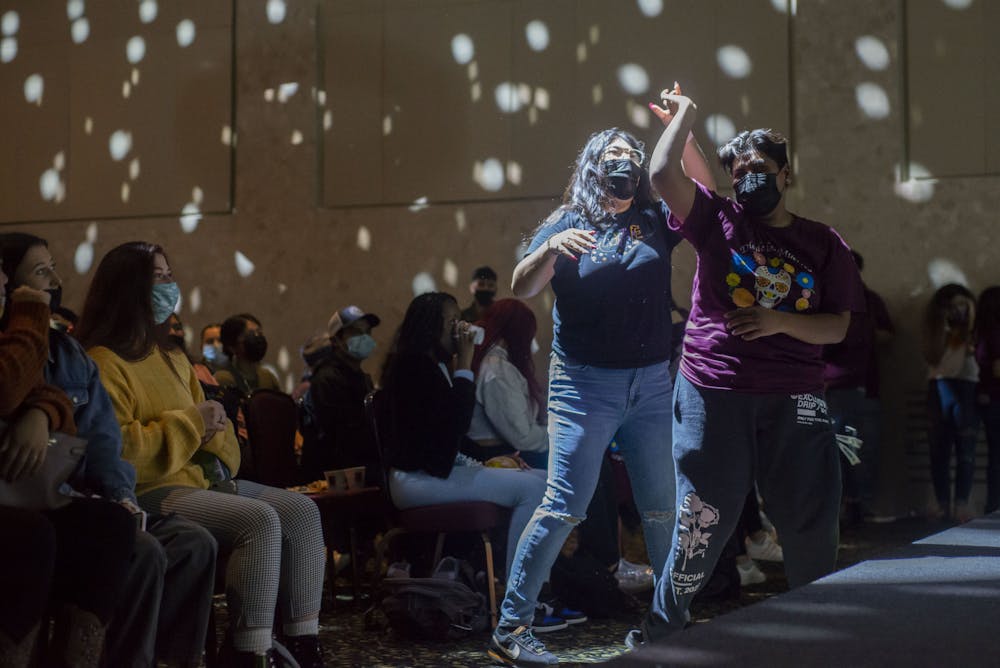Note: As Hispanic Heritage Month is celebrated by all Spanish-speaking American citizens, this article will be using "Hispanic" when referring to the general Hispanic community. "Latino/a/x" will be used when students identify as such. It's important to note that Hispanic is not interchangeable with Latino/a/x. Hispanic refers to “a person — or whose ancestors were from — a Spanish-speaking land or culture,” according to the AP Stylebook. Whereas Latinx "is a gender-neutral term to refer to a person of Latin American descent," according to USA Today.
Under former President Lyndon B. Johnson, Hispanic Heritage Week, which begins on Sept. 15, started as a week-long commemoration for the Hispanic population in the U.S.
However, 20 years later in 1988, former President Ronald Reagan expanded the celebration from one week to a 30-day period to be celebrated from Sept. 15 to Oct. 15.
The Hispanic Heritage Month date wasn’t chosen at random. Several Latin countries celebrate their independence days on Sept. 15, including Costa Rica, El Salvador, Guatemala, Honduras and Nicaragua. Mexico’s Independence Day also falls on Sept. 16 while Chile’s is on Sept. 18, according to HispanicHeritageMonth.gov.
The month pays tribute to Hispanic and Latino American ancestors that paved the way for future generations and celebrates and educates their heritage with others.
According to MSU’s Fall Semester 2021 Enrollment Report, there are a total of 2,985 students that identify as Hispanic or Latinx.
Although born in south Texas, journalism sophomore Sofia Mireles grew up for the majority of her childhood in Mexico and then came back to the U.S. in 2017.
Mireles didn’t celebrate or learn much about Hispanic Heritage Month because her community was majority Hispanic.
“When I got here, it was like it is a big thing because we are a predominantly white institution,” Mireles said. “So now here is where I am learning.”
Third-year law student Alaina Benjamin has realized as she has gotten older, her heritage as a Hispanic American holds more meaning to her.
“Having an opportunity to educate my friends who don’t identify as a part of the community … it’s really important and kind of allows me to also celebrate my roots,” Benjamin said.
Mexican American first-year law student Ulysses Grajeda believes it’s important for the community to celebrate and share their inspiring stories with each other.
"We acknowledge and recognize those who have done changes to the United States, who have been providing for their families, who have been fighting for rights and people that left their country to have a better future to achieve the American dream,” Mireles said. “And just to see how new students or new generations are digging the way for others and to not have the same struggles that first-generation students have, or our presentation of minorities and just represent and feel proud of who you are and where you come from.”
When environmental studies and sustainability senior Gianna Méndez was applying to a postgraduate scholars program, she was encouraged when she saw one Dominican graduate out of a few hundred students that were accepted.
“Even if it’s a small number, just seeing someone like me got into this very selective space, it’s an inspiration to see that it is possible that people like me have been in these spaces and isn’t something that's unattainable," Méndez said.
Further support for the community
Actively honoring and talking about Hispanic Heritage Month is a great stride forward, however, Hispanic students say that there is always work to be done to support the community.
Méndez, who is Afro-Caribbean, wishes students would understand that the Hispanic community doesn’t always physically look the same.
“A lot of people are surprised … whenever I start speaking Spanish or if I say I’m from the Dominican Republic,” Méndez said. “Usually there’s this idea of what someone from a Hispanic-speaking country should look like, and it typically goes around looking, Mexican. That’s very diverse because you have Afro-Mexican, you have indigenous people in Mexico, you have all this diversity.”
For Mireles, she hopes non-minority students can be more aware of the privilege they have.
Support student media!
Please consider donating to The State News and help fund the future of journalism.
Mireles remembers when moving out of dorms in the spring, many other students had families to help them move out. However, Mireles’ parents live in Mexico and weren’t able to come to help her.
“You have to appreciate that because we don’t have it,” Mireles said. “With that privilege, also help others succeed. It’s not just for you. It’s for everyone around you. Learn to advocate, but not just for you, but also educate yourself in minority rights and how you can help with things like that.”
Grajeda’s grandfather came to Michigan as part of the Bracero program: a series of law agreements that allowed Mexican men to legally work in the U.S. as seasonal immigrant farm workers.
From those family ties, Grajeda reflects on his time working in a public defender's office in New Mexico — a state with one of the highest Latino populations.
“The attorneys that work for indigent defense, criminal defense or that work in legal aid are not a reflection of that population,” Grajeda said. “So, you have attorneys that do not speak Spanish or do not identify with the Latino community.”
Students also enjoy celebrating Cinco de Mayo and other holidays that have a connection to Hispanic heritage, Benjamin said, but she encourages students to be diligent in learning why the history and reasoning behind why those holidays are celebrated.
However, Hispanic students see hope and improvement in awareness of diversity in the U.S.
MSU’s College of Law fall 2022 incoming class was the most inclusive class in 23 years, with 23% of students of color.
“That was something that I thought was really cool, and I think that just brings a lot of hope,” Grajeda said. “I’m really hopeful how we all have different ideas. We come from different backgrounds, so the class culture is so rich that you’re able to get different perspectives from different backgrounds.”
Discussion
Share and discuss “Heritage and hope: Hispanic students reflect and celebrate this month” on social media.







